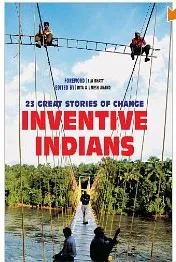[Book Review] Inventive Indians: 23 Great Stories of Change
Edited by Rita and Umesh Anand
2011 Westland / Nimby Books (Amazon)
259 pages; 23 chapters

This book is a good example of innovation journalism, particularly in the social sector in India. The compilation features a range of activists and innovators in healthcare, education, environment, media, children’s rights, agriculture and retail, who in their own ways are improving people’s lives and livelihoods. “Inventive Indians” joins a range of emerging books on changing India (see other reviews).
The 23 profiles of social entrepreneurship in this book were collected over six years of issues of Civil Society magazine. The style of writing is simple and engaging, and covers the background and achievements of social innovators, NGOs and corporate social responsibility initiatives in India.
Rita Anand is founder and editor of Civil Society magazine, and has reported widely on development issues. A teacher by training, she is a graduate from Loreto College, Kolkata, and holds a post-graduate degree in history from Jadavpur University. Umesh Anand is co-founder and publisher of Civil Society magazine. A journalist by profession, he has worked with leading Indian newspapers in senior capacities. He is from Kolkata where he studied at St Xavier's School and College.
“The shift from innovation to actualisation is becoming more and more important, not only for big corporate sector companies but for small traders, tiny manufacturers (including lone home-based workers), street vendors and farm labour. Indian civil society can play a key role in making India a garden of many blooms,” begins SEWA founder Ela Bhatt in the foreword.
“What can national planners learn from neighbourhood realities?” ask editors Rita and Umesh Anand in the introductory chapter. The balance for emerging economies to strike is between scale and sustainability. Innovations need to be put on bigger national and international platforms for replication and scale; one challenge is that many innovators are so absorbed in their immediate local objectives that they would prefer to leave issues of national awareness and policy to others in the innovation ecosystem.
I have summarised some of the profiles of innovators and activists in Table 1 below, but interested readers are certainly encouraged to read the full texts in the respective chapters, especially for the educational and work profiles of the innovators and their inspirational messages.
Table 1: Profiles and Achievements of Social Innovations
Other profiled organisations and activists include Rural Medicare Centre and Aparna Health Centre (affordable healthcare in Delhi), Attapady Hills Area Development Society (bringing a Kerala river back to life), Loreto House (inclusive education in Kolkata), Neelam Singh (crusading for girl child rights in Uttar Pradesh), Krishnamacharya Yoga Mandiram (customised yoga therapy in Chennai), Manimekhalai (restoration of irrigation channels in Tamil Nadu after the tsunami), and Dharmendra Hegde (bee-keeping in Karnataka).
Two corporate social responsibility initiatives are also profiled in the book: Tata Steel’s Rural Development Society (to train forest tribals in agricultural practices) and TVS Motor Company (promoting small businesses and empowering women in neighbourhoods around factories).
In sum, this is an informative and inspiring read, providing snapshots of what has been achieved on the social innovation front in India. Links to Web sites of the relevant organisations would have helped interested readers follow up and get more involved.
[Follow YourStory's research director Madanmohan Rao on Twitter at @madanrao]


![[Book Review] Inventive Indians: 23 Great Stories of Change](https://images.yourstory.com/cs/wordpress/2012/10/inventive_india.jpg?mode=crop&crop=faces&ar=16%3A9&format=auto&w=1920&q=75)




